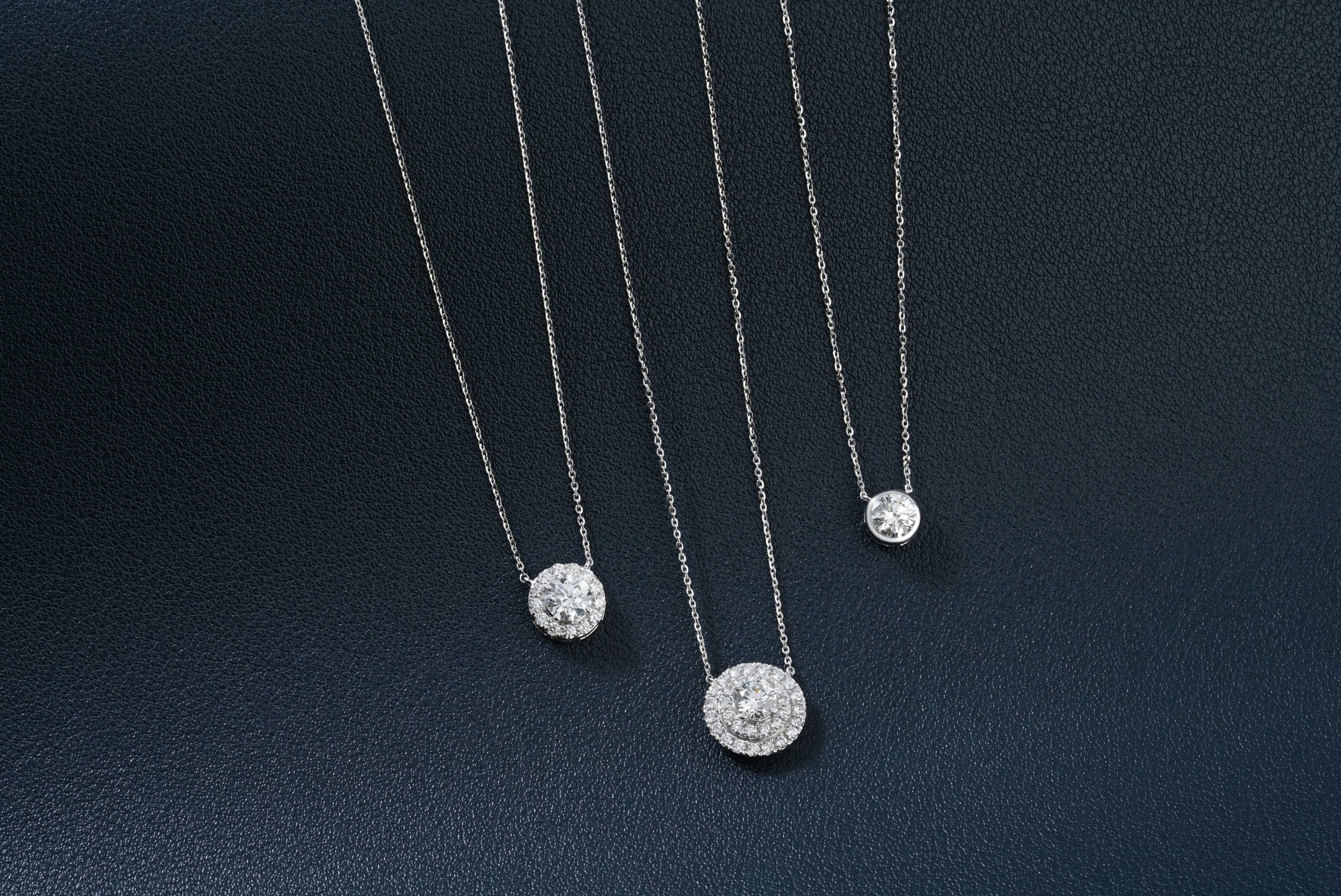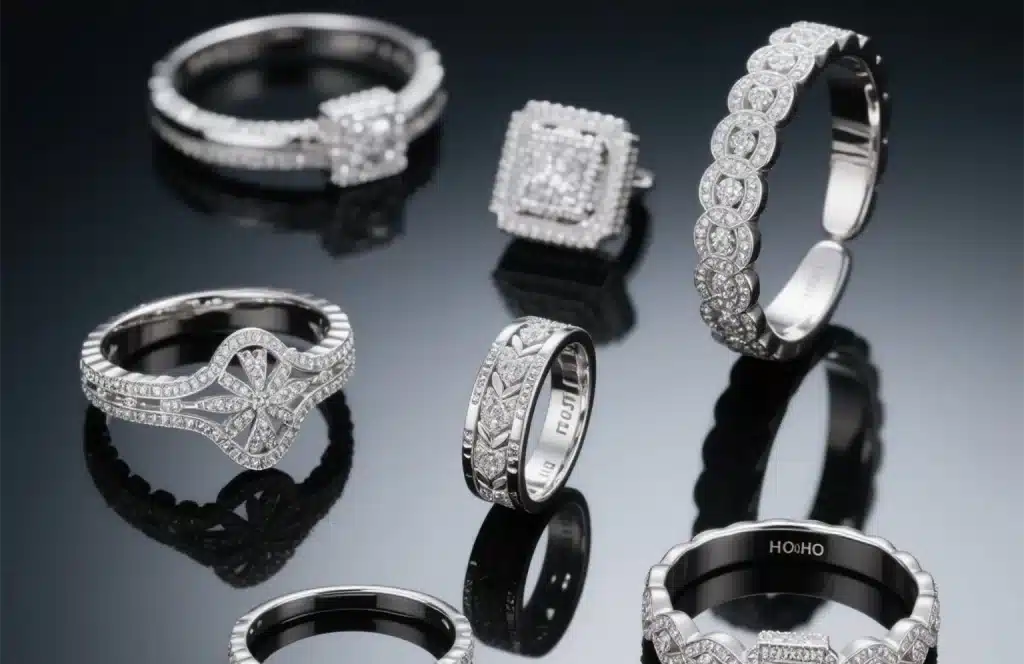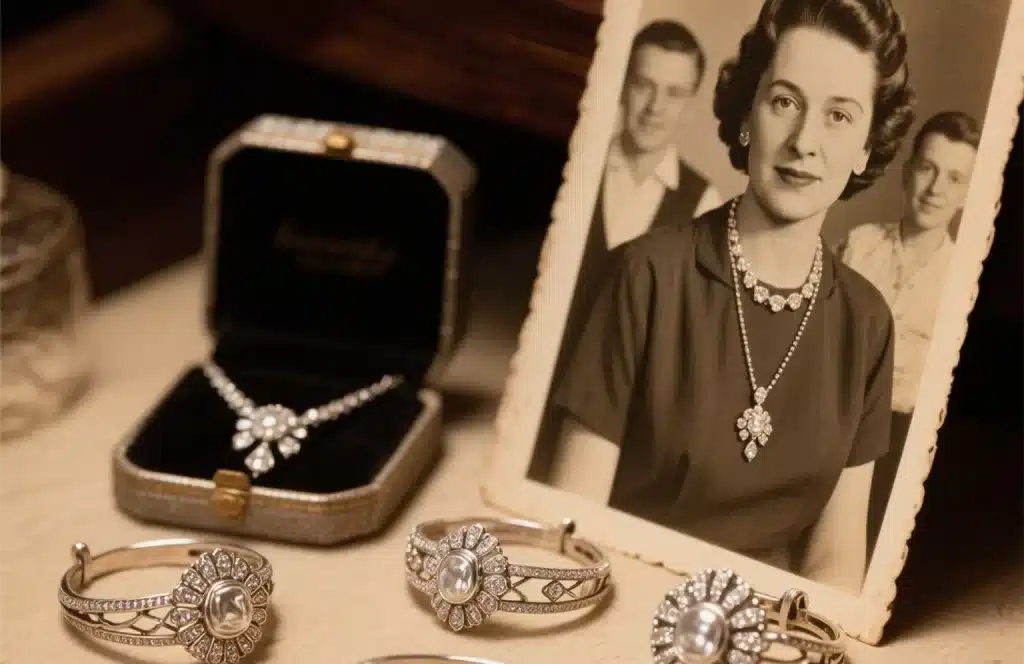How Long Does Sterling Silver Last? Tips for Longevity

Key Takeaways
- Sterling silver, an alloy consisting of 92.5% pure silver and 7.5% other metals (usually copper), balances beauty and durability — the main factors that determine how long will sterling silver last in jewelry use. long-term jewelry use.
- With simple, regular care — gentle cleaning, careful storage, and limited chemical exposure — your sterling silver can last decades and often becomes a family heirloom.
- Environmental factors in the United States, such as humidity, air pollutants (sulfur compounds), and temperature swings, speed up tarnishing but generally do not cause irreversible damage when pieces are routinely cleaned.
- Look for the hallmark stamped “925,” “sterling,” or “ster” to confirm genuine sterling silver. By contrast, silver-plated items have a much thinner surface layer and typically a shorter usable life.
- Buy from reputable jewelers and choose well-made pieces: quality craftsmanship and smart design reduce wear, make repairs easier, and extend the useful life of your silver jewelry.
How long does sterling silver last is a top question for jewelry buyers. In short: with proper care, sterling silver can last many decades — often a lifetime — and frequently becomes a passed-down treasure. Because it’s 92.5% fine silver alloyed for strength, sterling is resilient enough for everyday use in rings, bracelets, necklaces, tableware, and keepsakes.
Yes, sterling silver tarnishes — that’s normal. Regular cleaning and storing pieces in dry, low-oxygen conditions will slow tarnish and keep your items looking their best. The added metals in sterling make it stronger than pure silver, which is why sterling is the preferred choice for wearable silver jewelry.
Many American families pass down sterling silver across generations, showing how long-lasting well-made pieces can be. Below you’ll find practical tips and explanations to help your sterling silver remain beautiful for years to come.
What Defines Sterling Silver?

Sterling silver has a long-established place in jewelry and decorative arts because it combines attractive shine with practical durability. The right blend of quality sterling silver and small amounts of other metals creates a bright, workable alloy that helps sterling sterling silver last for many years when cared for properly.
The 92.5% Silver Standard
When an item is labeled sterling silver, it means the metal is 92.5% fine silver (often shown as “925”) with the remaining 7.5% made up of other metals. This 92.5% composition balances luster and durability: fine silver (99.9%) is too soft for everyday wear, while older coin silver (~90%) is less bright and more brittle.
The 92.5% standard explains why sterling is a preferred choice for rings, bracelets, necklaces, and household silverware. The “925” or stamps like “sterling” or “ster” are common indicators of authenticity; if you’re unsure, a jeweler can perform a professional test.
Why Other Metals Are Added
Small amounts of copper or other alloying metals are added to strengthen pure silver, preventing it from bending or deforming. Copper helps maintain shape and allows jewelers to create detailed designs that would be impractical with fine silver alone.
Some pieces receive a thin rhodium plating to slow tarnish and change the surface finish; that plating will wear with use and may need re-coating depending on wear patterns. (Note: product-specific claims about plating longevity or “waterproof” finishes should be confirmed with the maker.)
Identifying Genuine Sterling Silver
Look for hallmarks such as “925,” “sterling,” or “ster” stamped into the piece — these are reliable signals that the item is made to the 92.5% standard. At home, rubbing a clean white cloth over the metal can leave a faint dark mark from oxidation on genuine sterling silver, but for definitive answers, ask a trusted jeweler to test the piece.
How Long Does Sterling Silver Last: A Comprehensive Guide

Sterling silver combines style with structural strength, which is why it’s widely used in jewelry, tableware, and decorative objects. When cared for correctly, some sterling pieces can outlast a lifetime. Below we break down the main factors that determine how long sterling silver lasts and offer clear steps to maximize lifespan.
Quick summary: lifespan depends on construction quality, the alloy used, frequency of wear, environmental exposure (air, moisture, pollutants), and how you clean and store the piece.
1. How Long Does Sterling Silver Last: Potential Lifespan
Well-made sterling silver jewelry and household items can last decades — often a lifetime — with routine maintenance. Many American families still use rings, lockets, or silverware passed down from grandparents. Regular cleaning and proper storage will keep sterling silver pieces functional and attractive for generations.
Construction quality matters: a solid initial cast, precise polish, and strong joins all extend the useful life of a piece. In short, long sterling silver depends as much on craftsmanship as on material.
2. Key Factors Determining How Long Sterling Silver Lasts

Several interrelated factors affect tarnishing and wear:
- Environment: sulfur in the air (from industrial emissions, vehicle exhaust) accelerates oxidation and tarnishing; humid or coastal climates speed corrosion.
- Daily activities: contact with water, sweat, lotions, and chemicals increases tarnishing and surface wear.
- Storage: exposure to oxygen and moisture increases oxidation—anti-tarnish pouches or airtight containers reduce this.
- Frequency of use: daily wearing means more exposure to abrasion and chemicals; occasional pieces generally retain shine longer.
Small changes—like removing silver before showering or applying perfume after dressing—make a measurable difference over years.
3. Extend How Long Your Sterling Silver Lasts: Essential Care Tips (US Focus)

Airborne sulfur compounds are common even outside heavy-industry zones; combined with humidity, they cause tarnish. Temperature swings can loosen settings over time. To protect your pieces:
- Wipe jewelry with a soft cloth after each wear to remove oils and sweat.
- Store individual items in anti-tarnish pouches or sealed bags in a cool, dry place.
- Avoid wearing sterling during swimming (chlorine), heavy exercise (sweat), or when using household cleaners.
- When cleaning at home, use mild soap and warm water; rinse and dry thoroughly. Use a soft polishing cloth for light tarnish.
- For heavier tarnish, use jeweler-recommended cleaners or consult a professional.
Following these steps regularly will keep your sterling silver looking its best and lengthen its useful life.
4. Impact of Daily Wear
Daily use creates minor scratches, dents, and dulling. Activities like weightlifting, typing on hard surfaces, or gardening gradually score surfaces. Water exposure—especially chlorinated pools or hard water—can accelerate pitting and corrosion. Simple habits such as removing jewelry for strenuous activity and household chores significantly reduce wear.
5. Understanding Tarnish Versus Damage

Tarnish is a surface oxidation (often gray or black) caused by sulfur reacting with the metal; it’s cosmetic and reversible with proper cleaning. Damage—deep scratches, bent links, broken clasps, or loose stones—affects integrity and requires professional repair. Treat tarnish with polishing cloths or silver polish; seek a jeweler for structural issues.
6. How Alloys Affect Durability
Sterling silver is an alloy (92.5% silver + 7.5% typically copper). Copper improves durability but increases susceptibility to tarnish because it oxidizes more readily. Some makers use alternate alloys (zinc, small platinum additions) or protective coatings (rhodium or gold plating) to change color or slow tarnish. Protective platings help, but they wear and may need re-coating over time.
Choose pieces with durable construction and ask sellers about alloy composition and any surface treatments to set realistic care expectations.
7. Frequency of Use Impact
Pieces worn every day will show more signs of use faster than those reserved for special occasions. That said, regular gentle care (wiping, monthly cloth polish) offsets much of that wear—so daily-worn sterling can still last for decades with simple maintenance.
8. Craftsmanship Quality Matters Greatly
Quality craftsmanship—secure prongs, solid soldering, and thoughtful design—reduces stress points and makes repairs easier. Professionally made sterling silver from experienced makers typically endures longer and is easier to restore if damaged. When shopping, prioritize construction quality and buy from reputable jewelers.
9. Is Patina Good or Bad?
Patina is the mellowing of surface color that comes with age; many collectors value it for the character it adds. If you prefer a bright finish, polish it away carefully; if you like the aged look, leave the patina intact. Rapid or green discoloration can signal corrosion—seek professional cleaning if you notice unusual color changes.
Sterling Silver vs. Silver Plated
The world of silver jewelry gives you two common options: solid sterling silver and silver-plated pieces. They can look similar at first, but their composition, care needs, and longevity differ — understanding those differences helps you choose pieces that fit your budget and how long you want them to last.
What Is Silver Plated Jewelry?
Silver-plated jewelry gets its shine from a very thin layer of silver electroplated onto a base metal. That coating is usually only a few microns thick, so normal wear, abrasion, sweat, and chemicals will wear it away sooner than a solid silver piece.
Because the base metal is not silver, plated pieces can fade or reveal the core metal over time. Care (keeping them dry, wiping with a soft cloth) helps, but the plating will eventually thin and may chip if the item is heavily used.
Lifespan of Silver Plated Items
Under regular wear, many silver-plated items will maintain their appearance for a few years (often around 2–4 years), depending on plating thickness and how they’re treated. Thicker plating and gentler use extend that span, while constant abrasion, perspiration, or exposure to chemicals shorten it.
Store plated pieces in dry, individual pouches and wipe them after wear to keep them looking better for longer, remembering that the top silver layer is finite.
Durability: Sterling Wins Longterm
Sterling silver is 92.5% pure silver (the remaining 7.5% is usually copper), which gives it the strength needed for everyday jewelry. That composition makes sterling more durable and repairable than plated alternatives — minor scratches and tarnish can usually be polished out, and structural repairs (re-soldering, resetting stones) are possible.
Some sterling pieces are given protective coatings (rhodium or gold plating) to slow tarnish or change color; these coatings help but will wear and may require re-coating over time.
Spotting Plated vs. Solid Silver
Solid sterling pieces often carry hallmarks like “925,” “sterling,” or “ster” stamped into the metal. Plated items often lack these marks or may be marked “EP” (electroplate). Weight can also be a clue: solid silver typically feels heavier than plated pieces of the same size.
Why Sterling Is Worth It

Sterling silver costs more up front but usually lasts much longer with proper care, making it a better long-term value for heirloom-quality pieces. If you favor longevity and repairability over the lowest initial price, sterling is the smart choice.
When shopping for plated items, ask the seller for plating thickness (microns) and recommended care. For solid sterling, look for clear hallmarks and prioritize craftsmanship to get the longest life from your purchase.
Extend Your Silver’s Life
Traditional sterling silver is prized for its beauty and long-lasting charm, but everyday life—air, sweat, and storage choices—will affect its appearance. With a few reliable care habits, most sterling silver pieces can remain attractive for decades; many will last 30 years or more when properly maintained.
Below are practical, easy-to-follow tips to clean, protect, and store your sterling silver so it keeps its shine and resists tarnish for years to come.
Clean Your Silver Correctly

Prevention through regular cleaning is the foundation of sterling silver care. Dust, skin oils, and sweat build up quickly—especially in warm, humid climates. A simple routine keeps tarnish at bay:
- Daily: wipe pieces with a soft, dry cloth after wearing to remove oils and sweat.
- Monthly: soak in warm water with a drop of mild dish soap, gently rub with a soft cotton or microfiber cloth, rinse, and dry thoroughly.
- Avoid abrasive materials (paper towels, tissues) or harsh scrubs that scratch the surface.
Note: gentle daily wear can create a thin oil barrier that slows oxidation, but it doesn’t replace routine cleaning—especially after exposure to chemicals or heavy perspiration.
Choose Safe Cleaning Methods
Not all cleaning agents are safe for sterling silver or for pieces with gemstones or plated surfaces. Safe options include mild dish soap and warm water, commercial silver cleaners labeled for sterling, or jeweler-recommended wipes. Home remedies (a brief soak in diluted white vinegar or lemon-water) can work for light tarnish, but avoid aggressive mixtures like straight bleach, ammonia, or abrasive powders.
If your piece is rhodium- or gold-plated, use only mild cleaners to avoid wearing through the plating. Always test a small hidden area first when in doubt.
Store Your Silver Smartly

Storage is one of the simplest ways to prevent tarnishing. Practical storage tips:
- Use anti-tarnish pouches or cloth-lined jewelry boxes to limit exposure to air and moisture.
- Keep items individually wrapped or separated to avoid scratches from contact with other pieces.
- Store jewelry in a cool, dry place—avoid bathrooms or kitchens where steam and chemicals accelerate tarnish.
Airtight zip bags are a low-cost option to slow oxidation for pieces you won’t wear frequently.
Avoid Harsh Chemical Exposure
Chemicals in everyday products—hairspray, perfumes, lotions, cleaning sprays, and hand sanitizers—can accelerate tarnish or damage plated surfaces. Remove jewelry before swimming (chlorine and saltwater are harmful), cleaning, or applying cosmetics. Put jewelry on last, after dressing and applying perfumes or lotions.
Even foods with strong acids or spices can affect silver if you handle them while wearing rings—simple habit changes pay off over years of wear.
Know When Polishing Helps
Light polishing with a purpose-made silver polishing cloth is safe for routine maintenance and removes mild tarnish without scratching. Deep polishing using pastes or liquid cleaners should be done sparingly—over-polishing can wear down metal, especially on thin or plated pieces. Use short, gentle strokes and stop once the shine returns.
For most daily-worn sterling, a soft cloth polish once a month is enough to maintain luster without causing erosion.
Consider Professional Cleaning Options
If home cleaning doesn’t restore a heavily tarnished or structurally damaged piece, consult a professional jeweler. Pros can deep clean, re-plate rhodium or gold coatings, repair solder joints or settings, and inspect for loose stones. For heirloom or valuable pieces, an annual professional check keeps the piece safe and extends its usable life.
Following these cleaning, storage, and handling tips will help your sterling silver pieces remain beautiful and functional for many years—often for generations.
Recognizing Signs of Wear
Sterling silver is vibrant and versatile, but even with careful use it will show signs of wear over time. Spotting early warning signs lets you act before a small problem becomes a costly repair — inspect pieces regularly (every 6–12 months) and after heavy use.
Spotting Heavy Tarnish Buildup

Tarnish starts as a dulling or gray film and can progress to dark spots or a yellowish cast — this is surface oxidation caused by reaction with sulfur in the air and moisture. In polluted urban or tropical climates, heavy tarnish can appear within months, especially on pieces worn daily. Remove buildup promptly with a polishing cloth or jeweler’s cleaner to avoid stubborn stains.
Quick diagnostic tip: if the discoloration wipes away with a soft cloth and silver polish, it’s tarnish; if the metal has deep black patches that don’t lift, or greenish areas, get a pro opinion.
Identifying Deep Scratches or Dents
Feel the surface with a finger — deep scratches, gouges, or dents usually become obvious by touch. These marks weaken the metal and concentrate stress, making a break or further deformation more likely. If you find a deep groove or dent, schedule a jeweler inspection: many issues can be repaired before failure occurs.
Noticing Thinning Metal Areas
Thinning appears where metal repeatedly rubs against surfaces (ring bands, bangle edges). Thin zones may look shinier or sound slightly hollow when tapped. Thinning is a structural concern — if you spot it, stop wearing the item frequently and consult a jeweler about reinforcement or repair.
When to seek professional help: deep scratches, loose stones, broken clasps, or noticeable thinning all warrant expert attention. For heirloom or high-value pieces, an annual professional check (cleaning + inspection) is a good preventive step.
Note: product claims about “waterproof” or “non-tarnish” finishes should be treated as manufacturer statements — verify them with the seller and ask about care and expected longevity for those specific treatments.
Our Take: Sterling’s Enduring Charm
Sterling silver remains a wardrobe staple for both contemporary and vintage styles. Its soft glow and versatile look pair well with casual outfits and formal wear alike, making sterling a practical, attractive choice for everyday jewelry and special pieces.
Because sterling is 92.5% fine silver with 7.5% added for strength (usually copper), it strikes a balance between beauty and durability. That sturdiness is why bracelets, rings, and necklaces in sterling often become family heirlooms handed down across generations.
Why We Love Sterling Silver

Sterling silver delivers elegance at a more accessible price than gold or platinum, making it an excellent way to start or expand a collection. It complements a wide range of aesthetics and is commonly recommended for people with sensitive skin.
At HonHo Jewelry, we offer a range of 925 silver jewelry and finishes. (Brand claims about “waterproof” or “non-tarnish” treatments are manufacturer statements—check product details and care instructions for each item.)
It Ages Gracefully With You
Over time sterling develops a patina that many collectors appreciate for the depth and character it adds. If you prefer a bright finish, light polishing restores shine; if you like the aged look, leaving the patina intact is a valid aesthetic choice.
Handled well, a simple sterling silver necklace or bracelet can last for decades, becoming a tangible piece of family history.
A Sustainable, Lasting Choice
Compared with costume or fast-fashion pieces, quality sterling silver generally lasts much longer and creates less waste over time. Choosing well-made sterling favors repair and reuse over frequent replacement, making it a more sustainable jewelry option.
If you want longevity and value, prioritize solid 925 sterling and good craftsmanship over the lowest initial price—your pieces will repay that choice in years of wear and memories.
Conclusion

With the right care, sterling silver can stay with you for many years—even decades. Families across the United States still wear rings and use silverware passed down through generations; most surface tarnish and minor scratches are reversible with a quick polish rather than signaling the end of a piece’s life.
Silver-plated items tend to chip or wear through faster, while genuine sterling — if kept dry, wiped clean after wear, and stored properly — can endure for generations. Follow the care tips in this article, and your sterling silver jewelry will keep its luster longer. Have a question or a care tip to share? Leave a comment below — we’d love to hear your experience.
Frequently Asked Questions
How long does sterling silver jewelry usually last?
When properly cared for, sterling silver jewelry often lasts a lifetime or longer. Regular cleaning and safe storage prevent tarnish and preserve both appearance and structural integrity.
Does sterling silver tarnish over time?
Yes—tarnishing is a normal chemical reaction. Proper storage (cool, dry, anti-tarnish pouches) and routine cleaning significantly reduce how quickly sterling silver tarnishes.
Can you shower with sterling silver?
It’s best to avoid showering with sterling silver. Soap, shampoo, and water—especially hard water—can dull finishes and speed tarnish. Remove jewelry before showering to protect its finish and longevity.
Is sterling silver better than silver-plated?
Yes. Real sterling silver (92.5% silver alloyed for strength) is more durable and repairable than silver-plated pieces, which have only a thin surface layer of silver and typically wear faster.
How can I make my sterling silver last longer?
Store items in airtight or anti-tarnish containers, wipe them with a soft cloth after use, avoid exposure to perfumes and harsh chemicals, and use a polishing cloth monthly. For heavy tarnish or repairs, consult a professional jeweler.
What are signs my sterling silver is wearing out?
Look for deep scratches, dents, thinning (especially on ring bands or bangles), loose stones, or broken clasps. These issues usually need professional repair. Surface tarnish that wipes away with a polish isn’t structural wear.
Does sterling silver lose value over time?
Sterling silver generally holds more lasting value than costume or plated jewelry. While silver market prices fluctuate, well-made sterling pieces usually maintain value better than plated alternatives, especially when kept in good condition.
share this recipe:
Still hungry? Here’s more

How Much for a Gold Necklace 2026 Price Guide and Tips
Understanding Gold Purity and Karats When people ask “how much for a gold necklace?”, the

Spiritual Jewelry Symbols Guide- Meanings and How to Choose
How to Use This Spiritual Jewelry Symbols Guide Spiritual jewelry only works for you when

Understanding Wholesale Jewelry Pricing and How It Works
Understanding Wholesale Jewelry Pricing and How It Works When people see a ring that costs $6
Ready to Design Your Own Jewelry?
Have an idea in mind or need help shaping it? From sketches to finished pieces, our custom jewelry team will work with you step-by-step to bring your vision to life.
